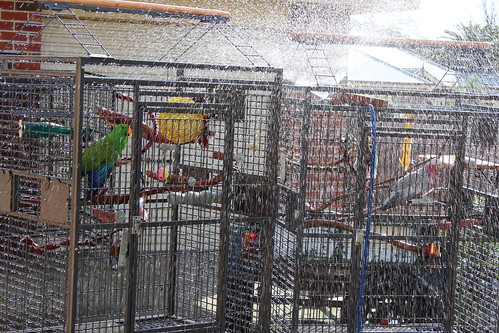
Two of my birds bathing under a sprinkler. (For those who are concerned about water conservation: I use tank water.)
One of my flock’s favourite ways to bathe is outside under a sprinkler. I set the sprinkler up on top of their aviaries and let the water fall down on them just like rain would. Everyone except for my macaw happily screams and shouts and plays under it. My eclectus gets as close to the sprinkler as possible as he prefers to be on the receiving end of a more forceful stream of water. If you were to listen to my macaw, sprinkler water is going to kill you and you must panic if you see it. (Someone prefers the bathing ritual of trying to drown humans in a warm indoor shower.)
I’ve got the perfect spot to do this, it’s a large paved area, with open sky. It adjoins an undercover verandah, which provides some shade if it’s too hot to leave them sitting in the sun to dry. It’s close to my water tank, so less chance I’m going to trip over the hose (yes I am that clumsy).
Sounds great, doesn’t it? While they’re out playing under the sprinkler I’m only a couple of metres away cleaning the bird room. The birdroom opens out onto the paved area, so I can easily keep an eye on the birds. It’s a lot easier to clean without bits of bird toy being gleefully bounced off your head!
Recently they were drip-drying in the open and I was a couple of metres away mopping the bird room when something suddenly changed. It was one of those moments when you know something is very wrong but you just don’t know how you know it? Everything suddenly seemed to be screaming DANGER. My birds were dead silent, absolutely everything seemed to be completely still.
Except for me that is. I dropped the mop. In a split second I’d covered those couple of metres and wound up next to the birds. I carefully followed their eyes to see what they were looking at, in order to work out what was wrong.
Every one of them was staring upwards and my macaw was making a low grumbling noise. They were absolutely terrified of a tiny speck that was circling directly above us. When I say tiny, I mean to my eyes it was almost invisible because it was so high up.
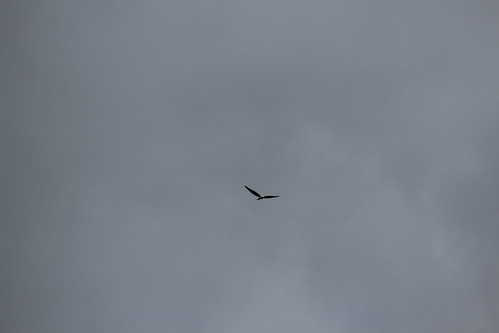
Different day (when my birds were safely away & I therefore had time to safely take a pic). This is a black shouldered kite circling above. The bird I’m describing in this story was much higher and much bigger, but this pic gives you a good idea of what I mean by “speck”.
The speck was a bird and the fact that I could see it when it was that high, told me that it was an exceptionally large bird. The circling action told me it was a bird of prey that was hunting and the fact that my birds and I were in the center of that circle wasn’t lost on me. It was a lot bigger than the normal birds of prey that I see. I knew I had only seconds to react. I also knew that I couldn’t move the birds to safety one aviary at a time because it would leave my remaining birds unprotected.
Well fortunately, my aviaries (even the super huge ones) are on platforms with wheels. That said they’re not exactly the lightest things to move. I swiftly pushed the aviaries together and with strength that I didn’t know I had, pushed the back one so that it pressed against all of the others. I moved them all simultaneously under my patio roof in one go. My back is still mad at me for doing it but it was worth it.
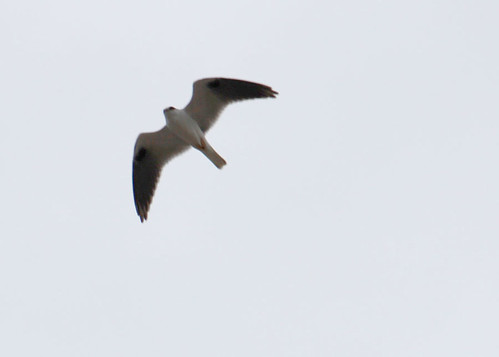
How do I know the speck in the last pic was a black shouldered kite? Using a different camera lens, I zoomed in.
The second I got the aviaries moving, all of my birds screamed in terror. I knew that the speck had seen that its chosen feast was beginning to get away and that the chase was on. The speck was diving on us.
What I didn’t know was that the speck was one of two wedge-tailed eagles. I have no idea where the speck’s partner was hiding but it reached my yard a full 10 seconds before the diving speck did. Fortunately the barrier of my patio roof was forcing the eagles into a side-on attack. They both landed in a tall tree nearby clearly trying to work out how to swoop in and collect their dinner.
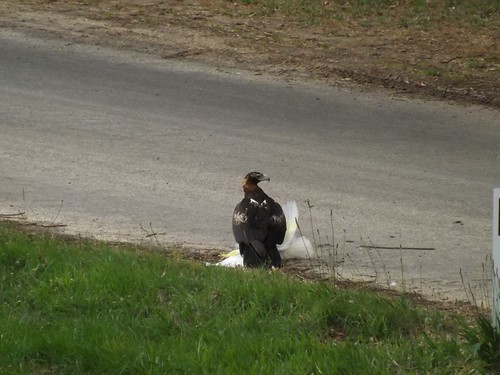
Note: both of the birds in this picture are wild birds. It’s not cruelty – it’s wild birds behaving normally. (A bird has got to eat.) I’ve included this picture because some people simply won’t believe that Wedge Tailed Eagles will eat large parrots (in this case a Sulphur Crested Cockatoo) on a daily basis. Don’t be fooled. Birds of prey will naturally see your pet birds as an easy meal. This is the type of eagle I was face to face with – you can see why I was so scared for my birds. Photo by: Leigh Sayers
Meanwhile I slammed on my exterior ceiling fans and fired a stream of water at them with the hose. It made them retreat a few metres but they weren’t willing to give up. On the bright side, their wary retreat bought me the precious minutes I needed to push each aviary up a ramp and lock them securely back in my bird room. This was done one handed while my other hand was firing off streams of water in the eagles’ direction. The bird room wound up being slightly pool-like as a result.
It was a close call and a bit of a lesson to me. If you had asked me the day before, I would have told you that I don’t get wedge-tailed eagles in my area. We get some smaller birds of prey, but nothing that big. Any bird can attack, but normally the wild birds around here are a lot easier to fend off. These eagles were extremely determined.
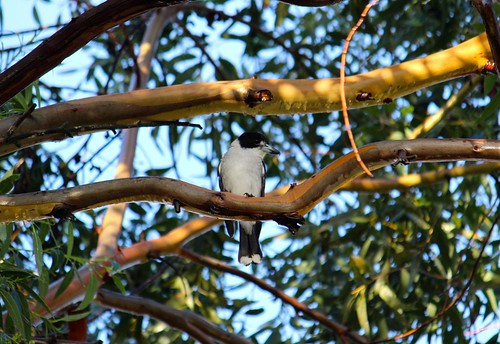
A wild “Butcher Bird” overlooking my yard. They get their name from their tendency to impale small live animals on a stick and strip the meat off it like a butcher. They’re not a harmless visitor around here, but easy enough to scare off. Their numbers have increased drastically in the last 12 months.
All of my cages and aviaries are sturdy and you’d think that would be enough to protect pet birds from being a wild bird’s dinner? That’s actually why I’m sharing this story. Many people think their cages and aviaries are infallible. There would be a reason these eagles weren’t even remotely concerned about my aviaries and that is quite likely to be due to their past experience. With my ongoing hose defence; they wouldn’t have been persisting in their attempts to get to my birds unless they knew that they’ve succeeded getting pet birds before. An aviary or a cage to them is no more than a foraging toy. Many people have learned that the hard way. I had no plan to do so.
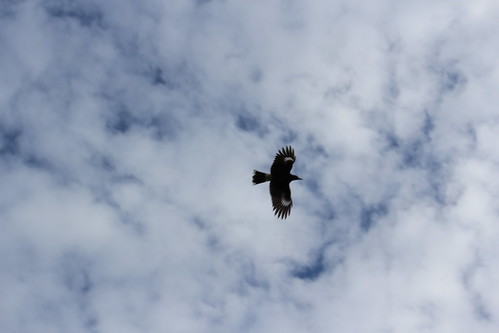
This Pied Currawong has its nest at the rear of my yard (interestingly it has chosen a tree that neighbours a raven’s nest, so they share guard duty). Every time it flies overhead my birds scream in fear even though it seems to have no interest in them.
The eagles returned at the same time, every night for the next two weeks. I’d see them in the sky, two tiny circling specks. You could set your watch by them. It’s worth remembering that if a wild bird finds an ongoing food source, it will add that food source to their daily routine until it is depleted or until they find something better. It meant that my birds didn’t get as much outside time during those two weeks, especially at that time of day. More than that, other bird people that I knew in the area were trading information about sightings and were also taking that sort of precaution. I’ve also marked the days on my calendar, as it wouldn’t shock me to see them again this time next year.
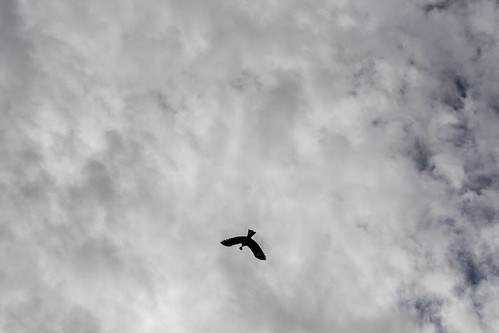
Mission accomplished – the same Pied Currawong returning to its nest with a small mouse. So their diet isn’t entirely vegetarian…
I have seen them since, but not consistently. The lesson in this is that times are changing. If you have pet birds, it’s worth being aware that some species of birds of prey are moving into more populated areas than where you’d traditionally find them. It pays to look up.
One last note – the pair of eagles that I have been dealing with are likely to have been drawn to my area because of the abundance of “easy food”. They are known for taking off with small dogs and cats too. So if you happen to have other pets and find yourself in the above situation – don’t forget to watch out for them too. I suspect the eagles’ main diet might actually be pigeons as I have a new neighbour a few streets away who has started regularly flying a racing flock. Having a new neighbour like that – is not good news.



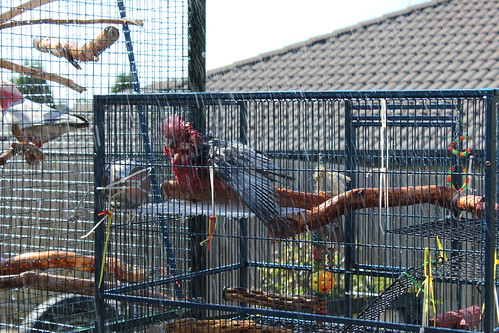

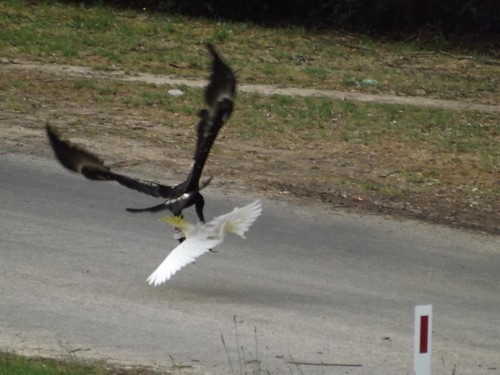
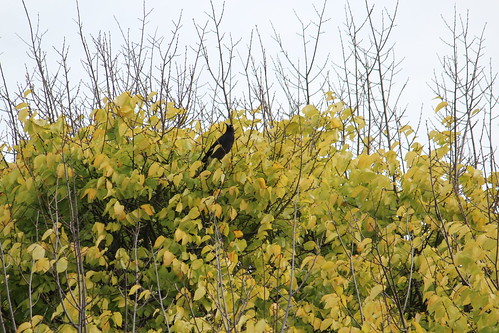
13 comments
hi mel, i just love reading your posts. as i am sick a lot of the times it gives me a lot of pleasure. many thanks nel
I have a stand for the blue and gold, He only goes out when I can be with em
Many, many years ago I had my African Grey, Princess out in my flower bed on a T stand with the sprinkler on for her, and my mother and myself right near her working. I had gone about 10 feet around the front of the house when I heard a horrific scream with squawking and growling and terrified noises coming from where Princess and mother were. I screamed and went running, mother screamed and the hawk that had tried to have Princess for lunch screamed too as it made a sharp ascent into the air. It had missed its prey, because Princess is such a scaredy cat that everything upsets her applecart, and she had dived into the flower bed and was under the bushes hollering and growling. That hawk terrorized the sky around our house for 2 weeks, and screamed on a regular basis. Needless to say, that was the end of our yard excursions with Princess. My heart couldn’t stand the strain of another try! So….I take her to our mountain cabin with us because she loves it up there, and what in the world happens? For two years straight we get terrorized by a hawk trying to get into our cabin, while leaving it’s feathers on our screens by dive bombing them to get after her! So her favorite spot got relocated! Really Now! What’s up with all this aggression by the wild bird kingdom? Don’t they know there are an abundance of pesky squirrels to eat?? Leave our pets alone and go get your own KFC somewhere else! HA!!
I LOVE THIS POST! I’ve read it 6x plus some. Not only does it give a day-in-the-life of a parrot, but it also has some great awareness in it. THANK YOU, MEL!
The argument that predatory birds must hunt has nothing to do with limiting their access to our precious and defenseless pet birds. They can easily hunt something else. I got the feeling it was okay to kill a cockatoo because the eagle has to hunt to survive. Not true, that eagle can kill a rabbit as easily as one of our precious pets. Whether the eagle goes after something else or not is up to it. I agree bird predators have to hunt to survive. But There is no way I would favor a predator over a pet bird. So the comment that they have to hunt is true, but not MY birds. If they hunt they are good at it . Their next meal will just have to be a rabbit. I will defend my African Grays no matter what. Even if it meant beating an eagle over the head with a broom. I love all wildlife and would never kill any wild creature but I will protect a domesticated prey animal.,
For the reasons explained I always cover the tops of the cages when the birds are outside. The suns angle is normally enough for the birds to still get the benefit. Our most frequent threat is sparrowhawks. Fortunately for us but not for them, we have a preponderence of small wildbirds in or garden – the sparrowhawks normal prey. Complacency is not an option.
My conure gets a lot of pleasure flying around my back yard or hanging out on me when I’m gardening. I sometimes catch her looking up and whenever I look to see what she is checking out, there is always a large bird—seagull, crow, and sometimes a hawk. Although she was raised in captivity, she knows the difference between a predator and a non-predator—amazing how strong that instinct is! When I hear or see Cooper’s hawks in the area, I don’t take her outside, but last week, she saw a turkey vulture, let out her alarm call and flew into a neighbour’s tree… it took a few minutes for me to call her back. Turkey vultures don’t pose any threat to her, but they are big, and the way they fly looks like an eagle’s flight. I will continue taking her outside, despite the dangers of predators. I think that the stimulation and pleasure she gets from being free outdoors in the summer is worth the risk, and if she ever does get killed by one, of course I’ll be sad, but at least I’ll know she had a good life, as stimulating as I could make it for her, with as little time in a cage as possible. And Mercedez, I respectfully disagree with you—you should never interfere with wild animals trying to survive—the eagle in the photo needed that cockatoo for nourishment. Wild animals do not have easy lives and by interfering by preventing the eagle from hunting, you could be putting its life in danger!
A small article in today’s paper described an owl that flew through an open sliding door in a 10th floor Idaho apartmen to eat one of two canaries in a cage. The owner leaves the doors open for cool air at night. He stated that he wasn’t going to close it. I hope he at least moves the cage.
I take walks with my yellow naped amazon on my arm and snuggled close to me (he is not shoulder trained). I am wondering if a hawk would attack me to get to Gabby. I am not concerned for myself but wonder if I would be a deterant? I have had a lot of nightmares about this scenario.
Thanks for this article. We had planned to install a second cage in our back courtyard for our African Ring Neck. We live on the West Coast of South Africa and have a huge amount of predator birds in our area. Now we’re thinking of installing a net over the courtyard. But the other day we had a Mongoose entering our house through the cat flap, it ran straight for the bird which got such a fright that it must have tried to fly off its perch. Lucky enough I heard its loud screaming and ran downstairs to find a bushy tail sticking out from under a dresser, the bird cornered underneath as well. I yanked the mongoose by its tail from under the dresser and it landed a few metres away and ran off, got to my bird which lost quite a few feathers and went straight off to the vet. We were so lucky! Normally, a mongoose can bite the head off a bird in no time! Nelson, our bird was slightly injured but otherwise OK. Thank Heavens!
Hi Mel What suburb do you live in? I have never seen a wild eagle
I agree with you 100%. Just because they are in a cage doesn’t mean that they are safe. I had a currawong rip the head off my canary through the bars of a cage.
There was a friend of a friend in Fl. who had her parrot on her screened in patio. It was a larger parrot but I can’t remember what type. She heard a blood curdling scream and came to find that a hawk had flown right through the screen and grabbed her bird! She was able some how to get her bird back and it survived. The vet said that usually hawks make a fast kill by snapping the neck so he said that this hawk was probably a young hawk. Your birds are not even safe on a patio. I’m wondering how a hawk would get your birds in such heavy duty cages?
Leave a comment